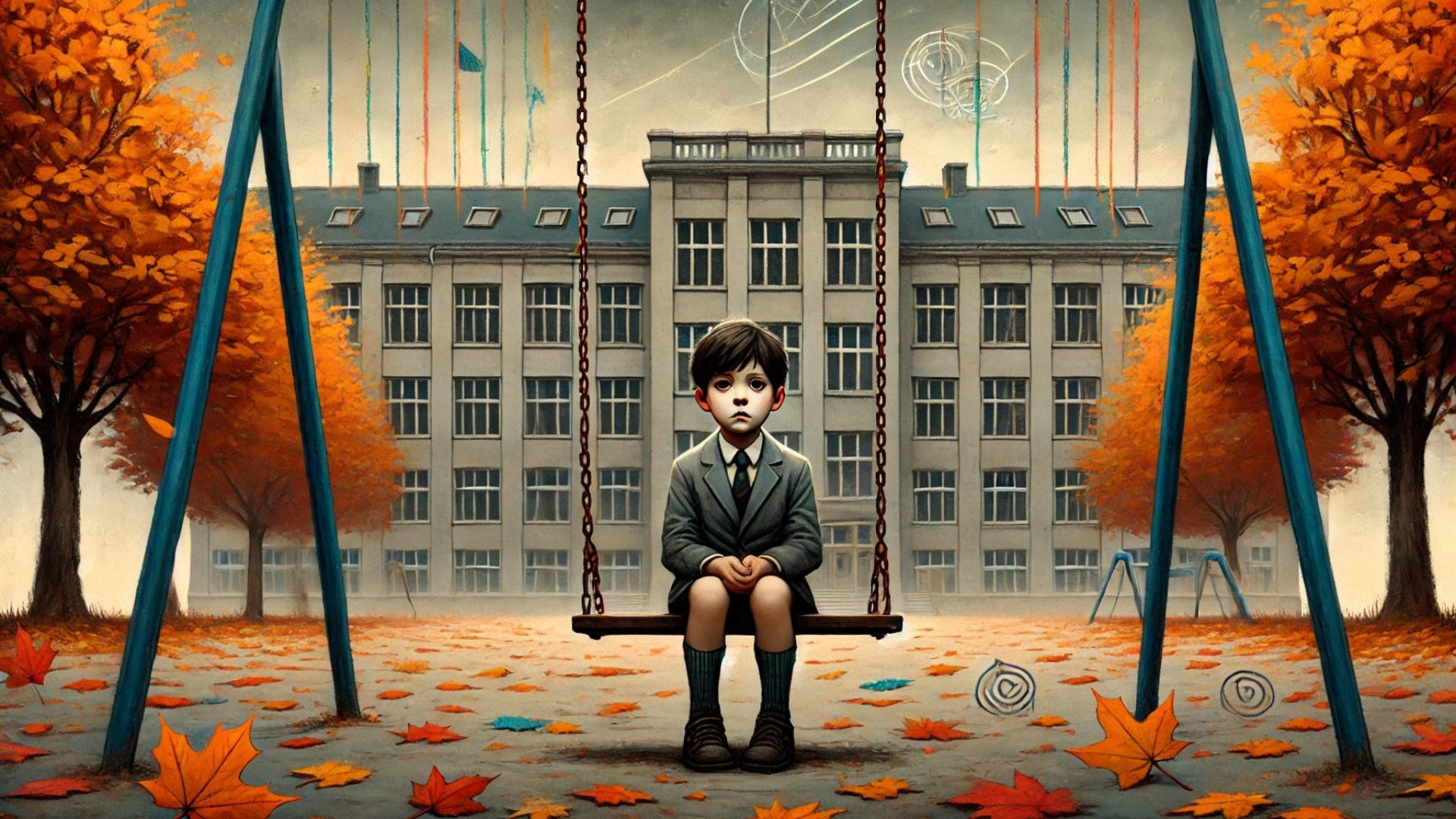Podcast Episode
Introduction
Welcome to this special episode of the English Plus Podcast—I’m your host, Danny. Today, we’re venturing into a story that challenges the way we think about learning, mental health, and the power of individuality. Have you ever wondered what happens when a child’s unique spark is dimmed by the very systems designed to nurture them? Or questioned whether a quick diagnosis and a pill can really capture the colorful complexity of a young mind? In today’s episode, we dive deep into these questions through our narrative, “Fractured Focus.”
In this story, you’ll follow Leo—a bright, imaginative nine-year-old whose world is gradually reshaped by the pressures of conformity and the rush to label his vibrant energy as ADHD. As his inner universe is slowly muted by medication and rigid classroom expectations, Leo’s journey forces us to ask: Are we truly supporting our children’s growth, or are we inadvertently stifling their creativity in favor of order and predictability? We explore the delicate balance between helping a child manage challenges and preserving the essence of who they are.
After the story, we’ll shift gears into a reflective commentary, unpacking the layers of Leo’s experience. We’ll examine how quick fixes can sometimes overshadow the nuanced needs of children, and how our education system’s drive for uniformity might be more harmful than it appears. And then—perhaps the most exciting part—we sit down with Dr. Adams, a respected psychiatrist, for a lively, in-depth interview. Together, we challenge established ideas, probe deeper into the realities of ADHD, and explore how we might reimagine a world that honors every child’s uniqueness.
So, are you ready to question what you thought you knew about ADHD, conformity, and the cost of compliance? Stay tuned as we unravel the story of Leo, spark meaningful dialogue, and invite you to think about how we can create a more compassionate, creative, and truly supportive world for our children.
Fractured Focus | A Story by Danny Ballan
In the quiet suburbs of Maplewood, where every lawn was meticulously trimmed and every front porch exuded a sense of order, the local elementary school stood as a testament to community pride and high academic expectations. The building, with its red-brick façade and neat rows of windows, was more than a school—it was a microcosm of a society that prized conformity and standardized success. Within these walls, every child was expected to behave, to follow a predetermined path of learning, and to conform to a script that left little room for individuality.
Nine-year-old Leo was one such child, though he was anything but ordinary. With a mop of unruly chestnut hair and eyes that shimmered with unspoken wonder, Leo’s mind was a vibrant tapestry of dreams and ideas. He often saw the world not in black and white, but in brilliant hues and shifting patterns. His imagination overflowed, transforming even the dullest moments of the school day into adventures of epic proportions.
In Mrs. Albright’s third-grade classroom, Leo’s differences were as apparent as they were misunderstood. Mrs. Albright was a kind soul, her warm smile and gentle tone hinting at the belief that every child had hidden depths waiting to be explored. Yet, the demands of the curriculum, the pressure to meet standardized test scores, and the unyielding expectations from the school board left little room for nurturing individuality. When Leo’s vibrant energy manifested in bursts of spontaneous creativity—drawing fantastical creatures in the margins of his notebook or speaking out of turn with ideas that defied the lesson plan—his actions were quickly branded as disruptive.
One crisp autumn morning, during a particularly spirited art lesson, Leo’s teacher called him to the front of the class. His fingers, stained with vibrant hues of paint, trembled as he clutched a drawing of what he described as “a flying dragon made of stardust.” Mrs. Albright’s eyes, though kind, betrayed a hint of exasperation. “Leo,” she began softly, “you have so much imagination, but please remember we’re here to learn the lesson for today.” The words, meant to guide him, stung instead, as if they were chipping away at a part of him that was precious and rare.
At home that evening, Leo’s parents—Mr. and Mrs. Carter—sat at the dinner table discussing the day’s events. Mr. Carter, a meticulous accountant, saw his son’s behavior as a disruption to the established order, while Mrs. Carter, a nurse with a gentle touch, worried silently that perhaps something deeper was amiss. Their concern was compounded when a referral arrived from the school: a suggestion to have Leo evaluated for Attention Deficit Hyperactivity Disorder (ADHD).
The evaluation, swift and clinical, led to a diagnosis. Dr. Michaels, a well-respected pediatrician known for his pragmatic approach, explained that Leo exhibited classic signs of ADHD. “It’s not uncommon,” he reassured them, “and we have very effective treatments. A little medication can help him focus, calm his energy, and make school a much smoother experience.” His tone, matter-of-fact yet distant, left little room for doubt. The notion of a quick fix was comforting—a neat solution in a world that often seemed too complex.
Yet, beneath the surface of these clinical decisions lay an undercurrent of tension. Leo’s eyes, usually alight with mischief and wonder, now flickered with a quiet sadness, as if he sensed that something fundamental was being taken from him.
***
The diagnosis set in motion a series of events that would forever alter the trajectory of Leo’s life. Within days, the prescription arrived, and a regimented schedule of pills began to punctuate his once free-flowing days. The transformation was subtle at first: a dampening of the outbursts, a silencing of the creative sparks that had once illuminated his every word.
One breezy afternoon, during a math lesson, Leo’s mind drifted to far-off lands—imaginary kingdoms where dragons soared and children ruled with wisdom and compassion. His gaze wandered to the window, where leaves danced in the gentle wind, and he longed to be part of that whimsical world. Suddenly, a harsh voice interrupted his reverie.
“Leo, please pay attention!” Mrs. Albright’s tone was strict, laced with frustration. In that moment, Leo felt as though his inner world was being forcibly pruned, the wild, beautiful growth of his imagination clipped in favor of a standardized form of behavior.
At home, the medication schedule was rigidly enforced. His mother would measure out the doses with clinical precision, her eyes betraying the conflict of a parent torn between the promise of normalcy and the fear of losing the essence of who her son was. “It’s for your own good, Leo,” she would say, her voice gentle but insistent. “This will help you be the best you can be.” But Leo’s response was often a silent retreat into himself—a retreat that grew deeper with each passing day.
A pivotal day arrived when Leo’s behavior culminated in a small yet profound rebellion. It was during a parent-teacher meeting, a setting charged with unspoken judgments and the weight of expectations. Mrs. Albright, caught in a difficult balance between her empathy for Leo and her duty to the institution, expressed concerns about his progress. “He’s not adapting well to the new regimen,” she admitted hesitantly, glancing at Leo’s parents as if seeking an ally in her quiet discontent.
Mr. Carter’s voice was firm, “We followed Dr. Michaels’ advice. Perhaps we should give it more time.” Yet, deep inside, Mr. Carter’s eyes told a different story—one of worry that his son’s uniqueness was being sacrificed on the altar of conformity. Mrs. Carter, however, harbored a silent hope that the medication would unlock a more manageable, predictable version of her son—a version that would fit neatly into the rigid framework of society.
Amid these growing tensions, Leo’s inner world began to fracture. During recess, while other children played tag or kicked a ball around, Leo sat apart beneath a sprawling oak tree. His notebook lay open on his lap, filled with sketches of fantastical creatures and abstract doodles that defied the conventional shapes taught in school. His best friend, Emma—a quiet girl with a keen perception—sat next to him.
“Leo, you look sad today,” she said softly, her eyes full of concern. “Are you okay?”
Leo hesitated, the words caught in his throat. “I just… I miss the colors,” he whispered. “Everything seems so… gray now.”
Emma frowned, not fully understanding, but her gentle presence offered a small comfort. In that moment, the playground—normally a canvas for laughter and camaraderie—became a silent stage for the inner conflict raging within him. The medication, intended to tame his restless mind, was instead dulling the brilliance that made him unique.
That evening, as the sun dipped below the horizon and the Carter household settled into an uneasy quiet, Leo lay in bed staring at the ceiling. The rhythmic ticking of the clock seemed to echo the steady, unyielding march of time—a time that was slowly erasing the contours of his once vivid imagination. He could not recall the last time he had dreamed freely, unburdened by the constraints of expectations and medication.
***
Weeks turned into months, and the subtle erosion of Leo’s spirit gave way to a mounting crisis. The classroom, once a vibrant stage for learning, had transformed into a battleground where conformity reigned supreme. Leo’s internal struggle reached a fever pitch on the day of the school’s annual performance—a celebration meant to showcase the talents of every student. For many, it was a joyous occasion; for Leo, it had become a crucible of conflicting emotions.
The performance was set in the school auditorium, its stage bathed in soft, golden light. The audience, filled with parents and teachers, buzzed with anticipation. Mrs. Albright’s voice, steady yet laced with an undercurrent of melancholy, guided the proceedings. Leo was to recite a poem he had written—a poem that, in its original form, had been a riot of colors and metaphors. However, under the influence of the medication and the pressure to conform, the poem had been sanitized, its vibrant imagery replaced with safe, measured words.
As Leo stepped onto the stage, the weight of expectations pressed down on him. The microphone amplified his quiet voice, and he began to recite the poem, each word measured and restrained. But as he reached the middle stanza, something within him stirred. The rigid cadence of the scripted lines cracked under the force of his suppressed emotions.
Suddenly, the words tumbled out in a torrent of raw, unfiltered emotion—a rebellion against the constraints that had choked his creativity for so long. “I am more than this shadow of calm, More than the pill that quiets my storm! I have dreams that scream, colors that bleed, A world beyond the chains of conformity’s creed!”
The auditorium fell silent. Mrs. Albright’s eyes widened, and Leo’s parents exchanged anxious glances. The performance, intended to be a display of polished achievement, had transformed into a poignant outcry. The side effects of the medication—its numbing of not just hyperactivity, but of the very essence of his being—had reached a breaking point. In that charged moment, Leo’s rebellion was as much an act of self-preservation as it was a cry for understanding.
A murmur of shock rippled through the crowd. Some parents looked on with dismay, others with sympathy, while Mrs. Albright struggled to maintain her composure. “Leo,” she called softly from the wings, her voice a mixture of worry and regret. “Please, come back to the script.”
But Leo’s defiant eyes shone with a clarity that cut through the silence. He could no longer reconcile the person he was expected to be with the vibrant soul that resided within him. His voice, trembling but resolute, continued its impassioned soliloquy, each word a testament to the cost of conformity and the price of a quick fix.
In that moment, the carefully constructed facade of order and discipline crumbled, replaced by a raw display of truth. The performance ended abruptly, leaving the audience in a state of stunned reflection—a silence that spoke volumes about the unspoken costs of suppressing individuality.
***
In the days that followed, the echoes of Leo’s outburst reverberated throughout Maplewood. The school board convened an emergency meeting, and whispers of reform began to circulate among teachers and parents alike. Mrs. Albright found herself at a crossroads, her conscience burdened by the realization that the system she had helped uphold was failing children like Leo. In quiet moments after school, she lingered in her classroom, pondering the loss of spontaneity, creativity, and the delicate spark that had once illuminated her students’ faces.
At home, the Carter household was enveloped in a somber mood. Leo’s parents, now acutely aware of the unintended consequences of the quick fix they had embraced, grappled with a mix of guilt and desperation. Mr. Carter, whose insistence on order and predictability had driven much of the decision-making, found himself questioning every choice he had made. Mrs. Carter, torn between the desire to see her son thrive and the nagging fear that the medication was erasing his true self, spent sleepless nights researching alternative approaches.
One rainy afternoon, as droplets traced melancholy paths down the windows, Leo’s mother gently sat beside him in the living room. “Leo, sweetheart,” she murmured, reaching out to stroke his hair, “I’m so sorry if we made you feel like you had to hide who you really are.” Her voice was laden with regret, and Leo’s eyes, though still guarded, softened with a glimmer of hope.
In the classroom, Mrs. Albright began experimenting with new methods to engage her students. She introduced activities that allowed for open-ended exploration—projects that celebrated differences, rather than punishing deviations from the norm. Some of her colleagues were resistant, clinging to the tried-and-true methods of discipline and standardization, while others embraced the change with cautious optimism.
Amid these shifts, Leo’s condition remained a topic of quiet debate. Dr. Michaels, the pediatrician who had once been so certain, now faced questions from concerned parents and educators alike. “Is medication really the best path for every child?” they asked, their voices tinged with uncertainty. While some studies supported the benefits of pharmaceuticals, an increasing number of voices began to advocate for a more nuanced approach—one that valued the individuality of each child and recognized that a one-size-fits-all solution could, in fact, do more harm than good.
Leo, for his part, oscillated between moments of clarity and confusion. There were days when the medication seemed to settle his mind, and others when it felt like a shackle, binding him to a version of himself that felt alien and muted. In private, he returned to that secret haven under the old oak tree at recess, where he would rediscover the sketches and scribbles that once defined his inner world. There, in the soft rustling of leaves and the gentle murmur of the wind, Leo found solace—a reminder of the vibrant spirit that still lingered within him.
It was during one such quiet afternoon that Emma, his ever-loyal friend, sat down beside him again. “Leo, do you think maybe things could change?” she asked, her voice tentative. “Maybe we can find a way to let you be you, even if it’s a little messy?” Leo looked at her, his gaze searching for an answer that had eluded him for so long. “I don’t know,” he whispered, “but I want to try. I want to feel the colors again, even if it means facing the storm.”
***
As autumn faded into the chill of early winter, the debates and quiet reforms in Maplewood stirred a slow but undeniable shift. The once rigid structures of the school began to accommodate a spectrum of differences. Mrs. Albright’s classroom, though still bound by the need for organization, blossomed with creative projects and discussions that invited each student to explore their own unique perspective. Yet, the scars of conformity and the consequences of over-medication lingered as a sober reminder of the cost of suppressing individuality.
Leo, now navigating his days with a mixture of medication and newfound personal strategies, found himself at a crossroads. One crisp winter morning, he wandered away from the buzz of the school corridors and sat alone in the quiet corner of the library. Dust motes floated in the pale light streaming through tall windows, and rows of books whispered secrets of worlds far beyond the confines of his own. In that silent sanctuary, Leo opened a battered notebook—a relic from the days when his imagination flowed freely—and began to sketch again.
His pencil moved hesitantly at first, as if testing the boundaries of a self he had long been forced to hide. Slowly, the images emerged: a sprawling, chaotic landscape filled with impossible creatures, vibrant hues bleeding into one another in a dance of rebellion and hope. It was not a perfect picture—far from it—but it was real, and it was his.
Later that day, as Leo handed in his latest drawing—a splash of untamed creativity—Mrs. Albright caught his eye. In that brief, wordless exchange, there was a mutual understanding: Leo was still Leo, despite everything. The system might still be entrenched in its ways, but within the cracks of conformity, the spark of his individuality endured.
At home, as Leo sat with his parents in the fading light of dusk, a quiet conversation began. Mr. Carter, with a voice softer than usual, said, “Maybe we’ve been too quick to fix what isn’t broken.” Mrs. Carter nodded, her eyes reflecting a mix of sorrow and hope. “I think we need to learn from this,” she whispered, “to see our children not as problems to be solved, but as unique souls to be cherished.” Their words, though small, marked the beginning of a journey—a commitment to understanding rather than controlling, to nurturing rather than conforming.
The story of Leo, with all its triumphs and tragedies, did not resolve neatly into a perfect ending. Instead, it left open questions that echoed long after the final page was turned. As the community of Maplewood grappled with its own role in shaping the lives of its children, Leo’s journey served as a poignant reminder that every child’s mind is a universe of possibility—one that cannot be contained by pills, policies, or the narrow expectations of a society that values conformity above all else.
In the end, on a quiet winter evening, Leo sat by the window watching the gentle fall of snowflakes, each one unique, drifting slowly to the ground. His future remained uncertain, and the system that had once dictated his every move was far from reformed. Yet, in that still moment, there was a sense of quiet defiance—a promise that the colors of his inner world, though subdued, would one day burst forth again, challenging a world that had long forgotten the beauty of diversity.
And so, as the snow continued to fall, the question lingered in the silent spaces between each flake: Can we ever truly see our children for who they are, or will we always try to shape them into something that fits our own limited vision of perfection?
Fractured Focus leaves us with no easy answers—only the raw, honest truth that in our quest for order, we may inadvertently rob our most precious souls of the vibrant chaos that makes them wonderfully, irreparably human.
Unpacking “Fractured Focus”
Welcome back, listeners. In the story we just heard, we followed Leo—a bright, imaginative child whose unique way of experiencing the world was gradually subdued by well-intentioned, yet ultimately oversimplified, attempts at “fixing” him. Today, we’re taking a closer look at what Leo’s journey tells us about ADHD, the push for conformity in education, and the broader implications for how we support our children.
Reflecting on Leo’s Journey
In “Fractured Focus,” Leo’s life is upended when a quick diagnosis leads to a regimented routine of medication. This isn’t just a story about a child struggling to conform—it’s a window into how society often addresses differences with ready-made solutions. The narrative shows us that while medication can help manage certain behaviors, it may also inadvertently quiet the creative spark that makes a child so wonderfully unique.
Many of us remember moments—whether from our own school days or through watching our children grow—where the pressure to fit in felt overwhelming. Leo’s experience echoes this reality. His internal world, once rich with color and possibility, begins to fade under the weight of expectations. And while the intentions behind these interventions are rarely malicious, the story gently reminds us that sometimes, in our rush to help, we might lose sight of what makes each child special.
Themes
1. Misunderstanding ADHD:
Leo’s story challenges the notion that ADHD is something to be quickly labeled and fixed. Instead, it invites us to ask: What if the symptoms we see are not just problems to solve, but signals of a mind that thinks differently? The narrative doesn’t dismiss the benefits of medical treatment entirely—it simply asks for a more nuanced approach that goes beyond a one-size-fits-all remedy.
2. Conformity in Education:
The setting of Maplewood’s elementary school represents more than just a building; it symbolizes the societal drive for uniformity. Schools are often seen as the ideal place to shape young minds into a standard mold. But as Leo’s struggles reveal, such environments can sometimes suppress the very qualities that fuel creativity and innovation. The story encourages us to consider: How might our educational systems evolve if we celebrated differences rather than curbing them?
3. The Cost of Compliance:
At its heart, the story is about the tension between safety and self-expression. It shows us that while structure and routine are important, enforcing strict conformity may come at a significant emotional cost. Leo’s quiet rebellion during the school performance isn’t an act of defiance for defiance’s sake—it’s a cry for recognition of his true self.
The Art of Storytelling
One of the strengths of “Fractured Focus” is its use of vivid moments that pull us directly into Leo’s inner world. We see his wonder in the sketches under the oak tree, feel his conflict during tense classroom moments, and hear his unfiltered outburst on stage. These moments resonate because they’re not mere critiques of a system; they’re reflections of real-life struggles. They remind us that every child’s journey is as complex as it is beautiful.
This narrative approach offers us a chance to reflect on our own experiences. Many of us have witnessed—or even been part of—situations where the pressure to conform overshadowed our innate creativity. By sharing Leo’s story, we’re encouraged to ask ourselves: Are we, as a society, giving enough space for difference, or are we too quick to silence the very qualities that can drive innovation and personal growth?
Moving Forward: A Call for Empathy and Understanding
The commentary here isn’t about assigning blame or pointing fingers. Instead, it’s an invitation to reflect on how we can better support our children’s diverse needs. Imagine a world where educators, parents, and policymakers collaborate to create environments that nurture individuality rather than constrain it. What might our schools look like if they were designed to encourage exploration and celebrate differences rather than enforce uniformity?
As you think about Leo’s journey, consider these questions:
- How do we define “normal” in a way that honors each child’s unique perspective?
- What can we learn from Leo about the balance between structure and creative freedom?
- In what ways might we, as communities, shift our approach to education and mental health so that every child feels truly understood and valued?
Join the Conversation
We’d love to hear your thoughts and experiences. Have you seen the effects of overemphasis on conformity in education? Do you know of alternative strategies that help nurture neurodiversity? Share your reflections and let’s continue this important conversation together. After all, every child’s mind is a universe of possibilities—and it’s only by embracing that complexity that we can truly support the next generation.
Thank you for joining us in this exploration. Let’s keep the dialogue open and work together to foster a more compassionate, understanding world for our children.
Interview with an Expert
Danny: Welcome back to the Educational Stories podcast. I’m Danny, and today we have a very special guest with us—Dr. Michael Adams, a practicing psychiatrist with extensive experience in child mental health and neurodiversity. Dr. Adams, thanks for joining us.
Dr. Adams: Thank you, Danny. It’s a pleasure to be here. I’m excited to dive into this conversation.
Danny: Let’s get right into it. We just finished our story, “Fractured Focus,” and the commentary touched on the struggles of understanding ADHD and the pressure for conformity in education. But I’d like to go deeper today. In the story, Leo’s diagnosis led to a rapid prescription of medication. In your clinical experience, what are some of the pitfalls of a rushed diagnosis and immediate pharmacological intervention for children who present with ADHD symptoms?
Dr. Adams: That’s a great question, Danny. One of the main pitfalls is that a rushed diagnosis can oversimplify a child’s experience. When we label a child quickly, we run the risk of reducing their complex behavior to a single category. In many cases, what we see as symptoms of ADHD might actually be expressions of creativity, or a reaction to environmental stressors. When we immediately jump to medication, we can sometimes overlook these contextual factors and inadvertently stifle a child’s natural coping mechanisms.
Danny: It sounds like the issue isn’t the medication per se, but rather how it’s implemented without considering the broader picture. How do you strike that balance in your practice?
Dr. Adams: Exactly. Medication is a tool—it can be incredibly beneficial when used appropriately. The key is comprehensive evaluation. Before reaching for the prescription pad, I advocate for a multi-dimensional approach: looking at the child’s home environment, educational setting, and even their social interactions. Behavioral interventions, counseling, and educational accommodations should be considered alongside or even before medication. It’s about treating the whole child, not just the symptoms.
Danny: In “Fractured Focus,” we see Leo’s creativity being dampened over time. That metaphor of “dimming the colors” is powerful. Do you think that by solely focusing on making children “compliant,” we risk losing what might be their most valuable assets—their unique perspectives and creativity?
Dr. Adams: Absolutely. Every child brings a unique set of skills and viewpoints to the table. When we impose strict conformity—whether through medication, rigid schooling, or standardized expectations—we risk stifling innovation and individuality. In fact, many successful people in creative fields have traits that, in a different context, might have been diagnosed as ADHD. It’s important to recognize that what some call “disruptive” behavior can be the early signs of exceptional creativity. The challenge is in creating environments that can channel that energy productively rather than simply suppressing it.
Danny: That raises an interesting point about societal norms. Often, our systems are designed to reward uniformity, and anything that deviates from that norm is seen as a problem. Do you see any promising shifts happening in education or policy that might allow for more individualized approaches to learning and development?
Dr. Adams: There are some exciting developments, indeed. Some schools are starting to experiment with flexible learning environments, where students have a say in how they learn. These models often emphasize project-based learning and encourage students to explore their interests rather than just adhering to a rigid curriculum. Additionally, there’s a growing recognition of neurodiversity in both educational and clinical settings. This shift is challenging long-held beliefs about what constitutes “normal” behavior and is paving the way for more personalized interventions. However, these changes take time, and they require a systemic overhaul—one that challenges deeply entrenched ideas about discipline and performance.
Danny: It seems like a real cultural shift is needed, not just in education, but in how we as a society view mental health and difference. What do you think are the biggest hurdles to achieving that shift?
Dr. Adams: One of the biggest hurdles is the inertia of established systems. Institutions, whether in education or healthcare, are designed around consistency and predictability. Changing these systems means challenging decades of practice, policy, and even cultural attitudes. Additionally, there’s often a fear of the unknown—if we allow more flexibility and embrace neurodiversity, there’s a concern that outcomes might become unpredictable. There’s also a significant influence from pharmaceutical companies in shaping perceptions of disorders like ADHD, which can skew public understanding toward a more reductionist view. Overcoming these challenges requires not only policy changes but also a cultural shift in how we value and support diversity in human behavior.
Danny: That’s a complex landscape. Let’s talk a bit about the role of the family in all this. In the story, Leo’s parents are caught in a difficult situation—trying to do what’s best while being influenced by societal norms and professional advice. From your perspective, what can families do to better navigate these challenges without feeling overwhelmed by the pressure to conform?
Dr. Adams: Families are on the front lines when it comes to supporting children, and they’re often the ones who feel the most pressure. I always encourage parents to trust their instincts. They know their child best. Seeking second opinions and looking for professionals who take a holistic view is crucial. It can also be very empowering for families to join support groups where they can share experiences and strategies. This community support can help them advocate for their child in schools and in clinical settings. Additionally, educating themselves about neurodiversity and understanding that a diagnosis isn’t a one-size-fits-all label can go a long way in helping families make informed decisions.
Danny: That makes a lot of sense. It seems that education for parents and open communication are key. Shifting gears a bit, one of the more challenging aspects of ADHD, particularly in children, is the risk of misinterpretation. For instance, behaviors that are simply a natural part of a child’s personality might be misdiagnosed as a disorder. How can clinicians better differentiate between true pathology and normal variations in behavior?
Dr. Adams: That’s one of the central challenges in our field. The line between what is pathological and what is merely a difference in temperament or developmental stage can be very fine. To navigate this, we rely on comprehensive assessments that look at patterns over time and across different environments. It’s important to observe whether a child’s behavior is causing significant functional impairment—are they unable to form relationships, are they falling behind academically, or is the behavior disruptive in a way that impacts their overall well-being? Standardized assessments, collateral information from parents and teachers, and sometimes even longitudinal studies help paint a clearer picture. It’s also essential to remember that many of the behaviors associated with ADHD can also be found in children who are simply exploring their boundaries or reacting to stress. A careful, individualized evaluation is key.
Danny: And what about the role of cultural expectations? Sometimes what one culture might see as normal energetic behavior could be labeled as problematic in another context. How does cultural perception play into ADHD diagnoses?
Dr. Adams: Cultural context is incredibly important. In some cultures, high energy levels and impulsivity might be seen as signs of creativity or leadership, while in others, they might be viewed as disruptive. The criteria for diagnosing ADHD are based largely on behavioral norms, which can vary widely between societies. This means that clinicians need to be culturally sensitive and aware of their own biases. It’s important to consider the child’s behavior relative to what is typical in their cultural and familial context. Clinicians who take the time to understand these nuances are better equipped to avoid misdiagnosis and to offer interventions that are respectful of cultural differences.
Danny: It sounds like there’s a need for a more personalized approach in every aspect of this process—whether it’s in diagnosis, treatment, or even in the way we structure education. Yet, personalized approaches often require more resources and time than standardized ones. How can institutions balance the need for individualized care with the realities of resource constraints?
Dr. Adams: That’s the million-dollar question, isn’t it? The reality is that personalized care is more resource-intensive, but the long-term benefits can be significant. Investing in individualized assessments and interventions can reduce the need for more intensive services later on, such as behavioral crises or academic failure. One strategy is to integrate multi-disciplinary teams in schools and clinics. When educators, clinicians, and parents work together, they can share the load and develop more efficient, targeted interventions. Technology can also play a role here—using data-driven approaches to monitor progress and tailor interventions can help maximize limited resources. It’s about shifting the perspective from short-term fixes to long-term outcomes.
Danny: Speaking of long-term outcomes, let’s address the idea of “compliance” versus “growth.” In the story, Leo’s brief moment of rebellion on stage is a powerful symbol of his struggle to reclaim his true self. In your view, what does true growth look like for a child who might be labeled with ADHD?
Dr. Adams: True growth, for me, is about enabling a child to develop a secure sense of self that integrates their natural inclinations with the skills they need to navigate the world. For a child with ADHD, that means learning strategies to manage challenges while still celebrating their unique strengths. It’s not about forcing a child into a mold that doesn’t fit them, but about equipping them with tools—be they behavioral techniques, academic accommodations, or social skills training—that allow them to thrive. When a child is given the space to express themselves authentically, even if that expression is unconventional, they often find creative solutions to problems that a more “compliant” approach might never uncover.
Danny: That’s a powerful vision. How do you see the role of schools evolving in this context? Are there specific models or programs that you believe successfully blend the need for structure with the celebration of individuality?
Dr. Adams: There are several promising models. Some schools are experimenting with what we call “flexible learning environments.” These schools prioritize student choice, allowing children to explore subjects in depth rather than following a one-size-fits-all curriculum. Project-based learning is another excellent example—it encourages students to work on projects that interest them, thereby integrating academic learning with personal passion. Additionally, some schools have implemented systems where students can set their own learning goals and are given the autonomy to work at their own pace. This approach not only respects individuality but also helps build self-efficacy and resilience. The challenge is scaling these models while maintaining quality, but the potential benefits are enormous.
Danny: And in terms of policy, what changes would you advocate for to support these more individualized approaches? Are there any legislative or administrative shifts that could help bridge the gap between current practices and these innovative models?
Dr. Adams: Policy changes need to reflect the evolving understanding of neurodiversity. For starters, funding for special education should be increased and reallocated to support individualized programs. There should also be incentives for schools to adopt flexible curricula and teacher training programs that emphasize differentiation and inclusivity. On a broader scale, we need policies that encourage collaboration between schools, families, and healthcare providers. This could involve integrated care models where mental health services are directly available within educational settings. Additionally, revisiting standardized testing protocols and grading systems to accommodate diverse learning styles would be a significant step forward. Policies that emphasize holistic development rather than narrow academic achievement can create a more supportive environment for all children.
Danny: It’s clear that the conversation around ADHD and education is much larger than just the classroom—it touches on societal values, healthcare, and even economic considerations. Before we wrap up, I’d like to touch on one more aspect: the future of research in this field. What areas do you think require more investigation to help us better understand and support children with ADHD?
Dr. Adams: There’s a lot we still need to learn. One critical area is the long-term impact of early intervention—both pharmacological and non-pharmacological—on a child’s development. We need more longitudinal studies that track children over decades to see how different approaches affect not just academic outcomes, but also social, emotional, and creative development. Another area is the role of technology in personalized care. Digital tools, such as adaptive learning platforms and real-time behavioral monitoring, have the potential to revolutionize how we understand and support individual differences. Finally, there’s a need for more research into the biological underpinnings of ADHD. Understanding the neurobiological mechanisms can help us develop more targeted interventions that respect the complexity of each child’s brain, rather than resorting to blanket solutions.
Danny: Dr. Adams, this has been an incredibly insightful conversation. It’s not often that we get to explore these topics in such depth, and your perspective truly challenges us to rethink our assumptions about ADHD and how we support children’s growth.
Dr. Adams: Thank you, Danny. I appreciate the opportunity to discuss these important issues. It’s essential that we continue to ask tough questions and push for systems that recognize and nurture the full spectrum of human potential.
Danny: Absolutely. As we’ve explored today, the journey from diagnosis to treatment is complex, and it’s vital that we approach it with empathy, nuance, and a willingness to question established practices. Before we let you go, do you have any final thoughts or advice for our listeners—especially for parents and educators who might be grappling with these challenges?
Dr. Adams: I’d say to trust your instincts. Every child is unique, and while it’s important to seek expert guidance, never lose sight of the individual behind the diagnosis. Look for signs of strength and creativity, and advocate for environments that celebrate those qualities. And remember, it’s perfectly okay to question the status quo—change often begins with a single, thoughtful inquiry.
Danny: That’s a wonderful note to end on. Thank you again, Dr. Adams, for sharing your insights and for challenging us to think deeper about these issues. I hope our listeners find today’s discussion as thought-provoking and empowering as I did.
Dr. Adams: Thank you, Danny. It’s been a pleasure, and I look forward to seeing how this conversation might inspire positive change in our communities.
Danny: And thank you, listeners, for joining us on this journey. Let’s keep the conversation alive—reach out with your thoughts, share your experiences, and let’s continue working together to create an environment where every child’s unique brilliance is recognized and celebrated.
Closing
Thank you for joining us on today’s thought-provoking journey through “Fractured Focus” and beyond. As we wrap up this episode, we’re left with more questions than answers—questions about the way we diagnose, treat, and ultimately understand the vibrant minds of our children. Did Leo’s story make you rethink the balance between discipline and creativity? Are there ways we can challenge the status quo in education and mental health to better support individuality?
We invite you to carry these questions with you, to discuss them with friends, family, or even your child’s teacher or doctor. Your insights and experiences are a crucial part of this conversation. If you found today’s episode engaging, enlightening, or even a little unsettling, please share your thoughts with us on social media or via our website. Your feedback not only enriches our dialogue but also helps us to keep these important conversations alive.
Until next time, let’s continue to question, to challenge, and to celebrate the uniqueness in every child. Thank you for tuning in to the English Plus Podcast—I’m Danny, reminding you that every mind is a universe of possibilities. Stay curious, stay compassionate, and as always, keep the conversation going.











0 Comments